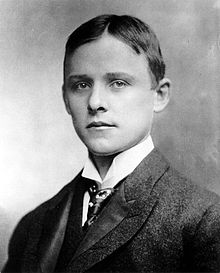- Charles Martin Hall
-
Charles Martin Hall 
Charles Martin HallBorn December 6, 1863
Thompson, OhioDied December 27, 1914
Daytona, FloridaNationality United States Work Significant advance Hall-Héroult process Charles Martin Hall (December 6, 1863 – December 27, 1914) was an American inventor, music enthusiast, and chemist. He is best known for his invention in 1886 of an inexpensive method for producing aluminium, which became the first metal to attain widespread use since the prehistoric discovery of iron.
Contents
Biography
Early years
Charles Martin Hall was born the son of Herman Bassett Hall and Sophronia H. Brooks on December 6, 1863 in Thompson, Ohio. He had one brother and three sisters, one of whom died in infancy. One of his sisters was Julia Brainerd Hall (1859–1925), who helped him in his experiments according to Trescott 1977. His family moved to Oberlin, Ohio in 1873, and he graduated from Oberlin High School. In 1880 he enrolled in Oberlin College, where he received a Bachelor of Arts degree in 1885. Hall was encouraged in his scientific experiments, which took place in a woodshed behind his family home, with ideas and materials from Professor Frank Fanning Jewett (1844–1926). The Jewett home is preserved in Oberlin as the Oberlin Heritage Center. The center features an exhibit called Aluminum: The Oberlin Connection, which includes a re-creation of Hall's 1886 woodshed experiment. The Hall House is also preserved in Oberlin, although the woodshed was demolished long ago.
Discovery
He had to fabricate most of his apparatus and prepare his chemicals, and was assisted by his older sister Julia Brainerd Hall (see Craig 1986, CIM Bulletin). The basic invention involves passing an electric current through a bath of alumina dissolved in cryolite, which results in a puddle of aluminum forming in the bottom of the retort. On July 9, 1886, Hall filed for his first patent. This process was also discovered at nearly the same time by the Frenchman Paul Héroult, and it has come to be known as the Hall-Héroult process. (Asimov 1982, p. 933)
After failing to find financial backing at home, Hall went to Pittsburgh where he made contact with the noted metallurgist Alfred E. Hunt. They formed the Reduction Company of Pittsburgh which opened the first large-scale aluminum production plants. The Reduction Company later became the Aluminum Company of America, then Alcoa. Hall was a major stockholder, and became wealthy.
The Hall-Héroult process eventually resulted in reducing the price of aluminum by a factor of 200, making it affordable for many practical uses. By 1900, annual production reached about 8 thousand tons. Today, more aluminum is produced than all other non-ferrous metals combined.
Hall is considered the originator of the American spelling of aluminum. According to Oberlin College, he misspelled it on a handbill publicizing his aluminum refinement process. The process was so revolutionary, and brought the metal to such prominence, that Americans have spelled aluminum with one "i" since. In the United Kingdom and other countries using British spelling, only aluminium is used. The spelling in virtually all other languages is analogous to the -ium ending.
Hall continued his research and development for the rest of his life and was granted 22 US patents, most on aluminum production. He served on the Oberlin College Board of Trustees. He was vice-president of the Alcoa until his death in 1914 in Daytona, Florida. He died unmarried and childless and was buried in Westwood Cemetery in Oberlin. Hall left the vast majority of his fortune to charity. His generosity contributed to the establishment of the Harvard-Yenching Institute, a leading foundation dedicated to advancing higher education in Asia in the humanities and social sciences.[1]
Recognition
Hall eventually became one of Oberlin College's most prominent benefactors. Students are fond of the statue of Hall made of aluminum. Because of its light weight, Hall's statue was once known for its frequent changes of location, often due to student pranks. Today the statue is glued to a large granite block and sits more permanently on the second floor of Oberlin's new science center, where students continue to decorate Hall with appropriate trappings on holidays and other occasions.
Hall won the Perkin Medal, the highest award in American industrial chemistry in 1911. In 1997 the production of aluminum metal by electrochemistry discovered by Hall was designated an ACS National Historical Chemical Landmark.[2]
Patents
- US Patent 400,664, Process of reducing aluminium from its fluoride salts by electrolysis -- C. M. Hall, applied 1886, granted 1889 TIFF Image of page from USPTO.
References
- Asimov, Isaac, Asimov's Biographical Encyclopedia of Science and Technology Second Revised Edition, Doubleday, 1982.
- Craig, Norman C., "Charles Martin Hall-the young man, his mentor, and his metal", Journal of Chemical Education (1986), 63(7), 557-9.
- Craig, Norman C.; Bickert, Christian M., "Historical metallurgy: Hall and Heroult: the men and their invention", CIM Bulletin (1986), 79(892), 98-101.
- Oskison, John M. (August 1914), "The American Creator Of The Aluminum Age", The World's Work: A History of Our Time XLIV (2): 438–445, http://books.google.com/?id=zegeQtMn9JsC&pg=PA438, retrieved 2009-08-04
- Trescott, Martha M., "The story behind the story: Julia B. Hall and aluminum", Journal of Chemical Education (1977), 54(1), 24-25.
- Oberlin College Archives [1]
Categories:- 1863 births
- 1914 deaths
- People from Geauga County, Ohio
- Oberlin College alumni
- American inventors
- American chemists
- Perkin Medal
- National Inventors Hall of Fame inductees
Wikimedia Foundation. 2010.
